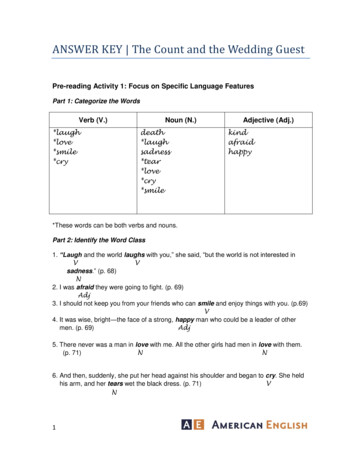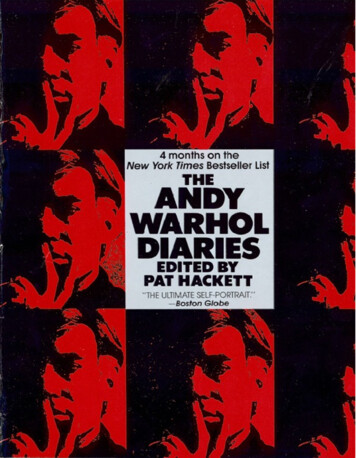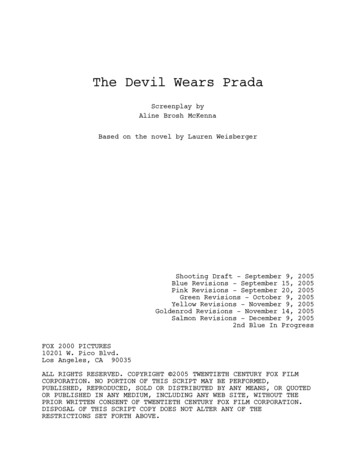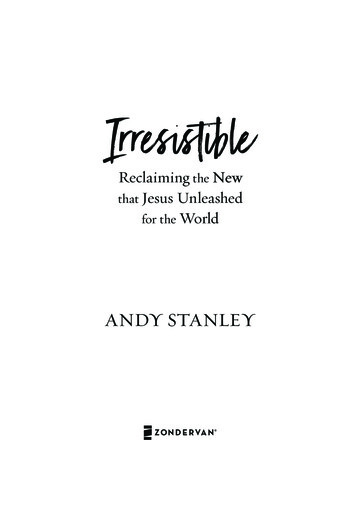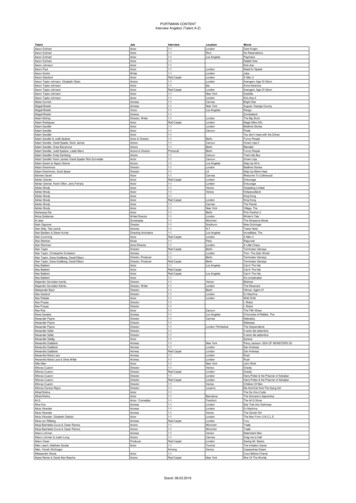
Transcription
ANDY LACK IS HELPING TO BUILD THEWORLD’S MOST INFLUENTIAL NEWS COMPANY.CONSTANTLY.NEWSWITHOUT ENDBYARTJAHNKEWEB EXTRAAndy Lacktalks aboutBloombergNews atbu.edu/bostonia.PhotographsbyJoshuaPaul30It’s a rainy spring morningin midtown Manhattan,and on the sixth floor of thefuturistic glass skyscraperknown as BloombergTower, Andy Lack islistening, energetically, asa half-dozen producersrun through a short listof potential guests forBloomberg West, a dailyhourlong TV show whosenext topic will be Google’scontroversial purchase ofITA Software. Lack’s headis bobbing in what couldbe a favorable opinion asthe discussion bouncesBOSTONIA Summer 201130-35.BostoniaSummer11 03.indd 306/7/11 2:28 PM
Andy Lack,outside Bloomberg Tower,where reporters’long days arelightened withfree food andabove-industryaverage paychecks.30-35.BostoniaSummer11 03.indd 316/7/11 2:28 PM
easily among people in the roomand those whoare videoconferenced in fromBloomberg’s SanFrancisco studio.The CEO of therecently formedBloomberg MediaGroup twistshis bushy eyebrows upward, heleans forward andcovers his chinwith his long finger—he’s Rodin’sThe Thinkerwith attentiondeficit disorder.Then the expressive head is bobbing again, andLack is somehowmaking eye contact with everypair of eyes inthe room, usingevery ounce ofhis panoramicpresence to keepthe ideas coming.32Keeping ideas coming is somethingabout 300,000 of them. Terminalsthat Lack has been famous for sincehave made Michael Bloomberg, whomost of these producers were watching also happens to be mayor of New YorkSesame Street. It’s also something thatCity, the 10th richest person in theis a required job skill at Bloomberg.country, according to Forbes, withBecause within Bloomberg, the global,a net worth of 18 billion. More to24/7, TV, radio, web, and every mediathe point, terminals are the reasonnow-and-yet-to-be-invented eternalthat Bloomberg is the only big mediavolcano of information, there can never company growing like Topsy whilebe enough ideas, never enough news.others wither. A year and a half ago,Lack (CFA’68) wonders aloudBloomberg snapped up founderingif continuing scrutiny by antitrustBusinessWeek magazine, now knownregulators will take a toll on Googleas Bloomberg Businessweek, forhonchos Larry Page and Eric Schmidt. 5 million, and the company has aThat might be something to talk about.well-deserved reputation among jourHe thinks someone should be sure tonalists as the lifeboat they’ve all beentalk about the overwhelming marketsearching for.share of internet searches that Google“Bloomberg has more reporterscommands.than the Wall Street Journal and theSuddenly, a black plastic blindNew York Times combined,” says Lack,descends, covering the windowwho arrived at Bloomberg two and halfthat overlooks East 58th Street andyears ago. “And we have more bureausdarkening the conference room.around the world than all the televisionIgnored by them all, the light-activatednetworks combined. Matt Winkler, edienvironmental control is one of manytor in chief of Bloomberg News, is theLand of Oz–like features of life atone who deserves enormous respectBloomberg, where infamously longfor building all that over 20 years.”workdays are leavened byDespite such firepower,free food and beverages,says Lack, a Boston Univernot to mention abovesity trustee, the challenge“It’s sensoryindustry-average paypresented by his latest job isoverload.checks. There are alsodaunting: Bloomberg wantsIt’s not likename tags for all, no matto be the most influentialanythingter how high-ranking,news organization in theyou’ve seenand a required fealty toworld, and as the personbefore.”“The Bloomberg Way,”responsible for an unseta 361-page rulebook fortlingly large portfolio thatjournalistic accuracy, fairness, andincludes television, web, radio, andstyle. Leads should be four paragraphsmobile and digital properties, he islong; proper credit must be given tothe chief influencer of that media.competitors.It’s Lack’s job to use an extraordinary“I think Google has 85 percent ofcollection of news from 2,300 reportthe market,” says one producer.ers in 146 cities. It’s Lack’s job to figure“No,” says another, “85 is theout how to slice, dice, and blend it.percentage of revenues that GoogleAnd it’s Lack’s job to send it back outmakes from search.”to more than 200 million homes that“Oh,” says a third. “So it’s like thewatch Bloomberg TV, plus millionsterminals.”of radio listeners and an estimated 16Everyone gets the joke. Terminals,million online readers. It’s Lack’s job tothe computer system that providesoptimize its presentation for television,Wall Street traders with financialcomputer screens, smartphones, andinformation and software tools, areiPads, and it’s Lack’s job to do that allthe golden goose of Bloomberg LP,day, every day, seven days a week.bringing in 85 percent of its revenues,“It’s sensory overload,” says Lack.reported to be more than 6 billion“When you walk into this building, it’sa year. A single terminal leases fornot like anything you’ve seen before. 20,000 a year, and Bloomberg leasesThe game here is ‘you must see it, shareBOSTONIA Summer 201130-35.BostoniaSummer11 03.indd 326/7/11 2:28 PM
TAKINGMULTIMEDIATO THEMAXT E L E V I S I O N Lack has recruited young talent fromGoogle, Yahoo!, ESPN, andCNN, and he has created anew generation of televisiongraphics.BIG NUMBERS The challenge: figuring out how to optimize deliveryto TV, computer screens, iPads, and radio.W E B Lack is building websites in Japanese, German,and Portuguese, all pushedto mobile devices as wellas computers.R A DIO Millions of peoplelisten to Bloomberg radioshows such as Charlie Rose,Bloomberg BusinessweekRadio, and Bloomberg West.I PA D Tablets are one of atleast four types of screensthat Bloomberg is designingfor, trying to get as muchcontent on as many screensas possible.2,300 reporters in 146 cities 200 million homes watch Bloomberg TV 16 million online readersit, read it, visualize it, experience it,’and it never stops. There is an endlessstream of information.”THE BAD OLD GOOD OLD DAYSIn November 1992, the NBC weeklynews magazine Dateline aired a15-minute story on the dangers ofcertain General Motors trucks whosegas tanks were alleged to ignite aftera sideways collision. The segmentincluded stunning video, replete withsmoke, flames, and moral outrage,all calculated to rivet the attentionof Dateline viewers, which it did. Butit also riveted the attention of GMinvestigators, who were tipped off thatthe frightening explosions had beenignited not by a collision, but by rocketscarefully set in place by the Datelinecrew. Busted and disgraced, NBCissued an on-air apology, fired threestaffers, and accepted the resignationof NBC News president MichaelGartner. Then it looked around for areplacement.Jack Welch, CEO of NBC parentcompany General Electric, thought itmight be worth talking to Lack, thena 10-time Emmy Award–winningCBS producer known for creatingthe newsmagazine West 57th. Welch,regarded as one of the toughest andbest business leaders in the world,would later describe Lack as “the bestjob candidate I ever met.” They’veremained close friends for 18 years.“I’m usually offered jobs wherethere is something big and broken,”says Lack. “There is a group of peopleand that’s their line of work. I wasalways in the group chosen for thingsthat needed to be rewired, or startedfrom scratch.”Neal Shapiro, who replaced thequickly departed executive producerof Dateline, recalls Lack’s arrival. “NBCwas completely adrift,” says Shapiro,now president of WNET. “Andy is abig personality. You get the sense thatyou can do anything if you aim high.He came in and gave everyone thesense that he was going to be bold, sethigh goals, and it was a new day andwe were going to pick ourselves up.He immediately righted the ship.”Guided by that big personality, NBCNews rose to the number-one positionin the ratings, while Lack rose to NBC’snumber-two position, where he reportedly butted heads with network chiefBob Wright. Then he got a call fromold friend Howard Stringer, who wasrunning another company in deeptrouble.Sony Music Entertainment, like allbig music studios in 2003, had beenrun over by a truck called the internet.Lack, hired as chairman and CEO, cut2,000 of 8,000 jobs, then guided thedivision to the safety of a billion-dollarmerger with BMG, a deal that built theworld’s second largest music company.As soon as the ink was dry, a revolt byBMG bigwigs swept Lack from power.“That was tough,” he says. “But youonly learn from the hard stuff. Youdon’t learn anything from victory laps.”Lack’s famous optimism may havebeen born at the Browning School, aday school he attended just a few cityblocks from where the BloombergTower stands. His first professionalinfatuation was theater, spawnedSummer 2011 BOSTONIA30-35.BostoniaSummer11 03.indd 33336/7/11 2:28 PM
one night in 1957 when his mothertook him to see West Side Story. Hegraduated from the College of FineArts in 1968 with sufficient talent toearn a minor role in the Broadwayproduction of Inquest, the story ofJulius and Ethel Rosenberg. Lack wasmaking TV commercials for productslike Pampers and Avis rental carswhen he was introduced to Stringerin 1976. Then a producer at thelegendary CBS Reports, Stringer inturn put him in touch with 60 Minutescreator Don Hewitt. Hewitt gave Lacka shot on a short-lived personalitydriven effort called Who’s Who,and then moved him quickly to 60Minutes. Lack later became executiveproducer of CBS Reports for sevenyears and executive producer of thegroundbreaking West 57th for fouryears, but it wasn’t until Welch broughthim to NBC that he entered the industry limelight.“Andy had a real vision for NBCNews,” says Jeff Zucker, a 21-yearveteran of NBC who rose to presidentand CEO of NBC Universal. “He knewwhat he wanted, and he executedagainst that vision. He created anatmosphere of teamwork that allowedall the programs to work together. NBCNews became a very coherent placeunder Andy. Andy’s incredibly smart,well-versed in many issues and topics.He’s a real Renaissance man. He’s alsobigger than life. He’s a total showman,and he was fun just to be around.”Dateline executive producerShapiro remembers Lack as a managerwho knows when to guide and whento stand back. “He would give me boldnew ideas of where he wanted to goand the type of stories he wanted todo,” Shapiro says. “They were smartsuggestions and good insights, but hewas not going to be constantly lookingover people’s shoulders. He realizedthat with good people that was notgoing to be successful.”EVERY-SCREEN STRATEGYNearly two decades later, Lack’s suggestions and insights are as abundantas his optimism. In a videoconferencewith Bloomberg producers from London, he watches an interview with34retailing billionaire Philip Green, shotfrom a 2 million deal in Russia tofor his recently launched Eye to Eye, aa proposal from a sheik in Dubai tohalf-hour conversation with self-madestart an Arabic language channel tobillionaires and entrepreneurs.a distribution deal in Hong Kong to a“A lot of the b-roll was repetitious,”touch screen rollout in Asia to publicLack tells his overseas producers. “Herelations problems in Germany. “We’vewas saying the same old, same old. Wegot to get Germany figured out,” heshould make sure it’s fresh. And yousays. “I don’t have a clue how to do itshould be asking him questions like,from here. We have to get someone onwhat’s the worst deal, what’s the bestthe ground.”deal you’ve ever made.”Lack’s next meeting, which conLack has made several additionsvenes seconds after the London telethat have changed the face of Bloomconference ends, takes him fromberg TV. He has added Charlie Roseglobal programming to technologicalaround the world and launchediterations. There is an update onBloomberg West and Bloomberg Gamea new website devoted to mergersChangers, a series of profiles of moversand acquisitions, a proposal to putand shakers, including Apple’s SteveBloomberg video on 1,500 videoJobs, hip-hop king Jay-Z, and Facebook screens atop gas pumps in the Trifounder Mark Zuckerberg. He hiredState area (“The only thing we can’ta young team, mostly in their 30s,report on is petroleum”), a report on arecruited from Google, Yahoo!, ESPN,new Bloomberg iPad app that has beenand CNN to drive Bloomberg forwardsubmitted to Apple for approval (“Theyin multimedia. He also created a newwant to feature it in their stores”),generation of TV graphics and movedand news that Bloomberg websiteshis anchors to a central spot in thehave seen record traffic lately, evenBloomberg newsroom.without the numbers from Bloomberg“The essential valuesBusinessweek, which Nielsenand principles that informratings still attribute to thethe craft of journalismmagazine’s former owner,“I don’t thinkare harder and harder toMcGraw-Hill. “What?” sayspeople evenprotect,” Lack says. “TheLack. “They still give them totalk aboutworld is more competitive.McGraw-Hill? That’s crazy.”traditionalThe digital age placesThe meeting is a 30televisionnew challenges on oldminute illustration of whatanymore.”media and the networkhas changed in media: it’s notnews organizations thatjust about programming anyI grew up in. There used to be newsmore. It’s about presentation, manyorganizations that made a fewkinds of presentation. Lack calls itprograms a day, and they were preBloomberg’s three-screen strategy,dictable. One was at 6:30 in thea commitment to get as much contentevening, one at 7 o’clock in the mornas possible on every device with aing, and one famous one on CBS onscreen display, no matter how smallSunday evenings. Today we haveor large. “There is the HD screen,” henot only a 24-hour news business,says. “And that now offers the opporbut a global 24-hour news businesstunity to include lots of visual inforthat is broken down into minutes,mation and data that we have notnot days and hours. Today I don’tbeen able to show viewers until now.think people even talk about tradiThere is the PC screen, and there istional television anymore. It’s aboutthe screen clipped to your belt or invideo circulating around the planet inyour pocket. There is also the tablet,many different media and formats.so our three-screen strategy is reallyIt goes online and it goes to youra four-screen strategy now. Call itiPad or smartphone. At Bloomberg,an every-screen strategy. We are workit’s everywhere.”ing with multiple platforms and tryingIn 30 minutes, Lack’s discussionto make sure that we are smart acrosswith his European colleagues bouncesall of them.”BOSTONIA Summer 201130-35.BostoniaSummer11 03.indd 346/7/11 2:28 PM
Lack promises Bloomberg websites in Japanese,Spanish, German, andPortuguese, all pushed outto new mobile devicesthat have yet to be imagined. “With mobile, we’rejust at the beginning,” hesays. “Nobody’s got muchof a business model thereyet, but I think mobilewill be one of the gamechangers at Bloomberg.”Eventually, Lack admits, some kind of gamechanger will be requiredto lift the bottom line:word has come down thatBloomberg Media mustoperate as a sustainablebusiness.“Up to now it’s beenthe marketing arm of theBloomberg terminal,”he says. “But all of thebusinesses need to bestand-alone businessesthat make sense forBloomberg, and goingback a few years they haddifficulty rationalizingsome of their activities.We’ve been working onthat, and we are moving swiftly to bea real and sustainable business withinthe next few years.”If the next few years are anythinglike the last few years, those businesseswill have a tough row to hoe. Accordingto the 2010 State of the News Mediareport by the nonprofit public opinionresearch group Pew Research Center,newspapers, including online papers,saw advertising revenues tumble 43percent in the previous three years.Network television ad revenues fell8 percent (news alone probably fellmore), local television ad revenuesplummeted 22 percent, radio dipped22 percent, and magazine ad revenueswere down 17 percent. A more recentstudy, released by Pew in March 2011,reports that for the first time in atleast a dozen years, the audience atall three cable news networks shrunk.Prime-time viewership fell 16 percentand daytime viewership 12 percent.And network news viewershipcontinued its downward trend.One glimmer of hope: thePublishers Information Bureaureported in April that BloombergBusinessweek ad pages leaped 49percent in the first three months ofthis year.Lack, unsurprisingly, is full of hope.“There are plenty of examples of 24hour news businesses that are doingwell, both on a financial basis and on ajournalistic basis,” he says. “Although,lord knows, there are plenty of criticsout there who correctly wag theirfingers at the quality of cable news.”Chris Daly, a College of Communication associate professor of journalism and the author of a book on thehistory of journalism, says Bloomberg’saspirations will not be easily realized.“They have a very ambitious goal,” hesays. “But as everyone who has triedhas discovered, it is very expensive“Lord knows,there are plentyof critics outthere who correctly wag theirfingers at thequality of cablenews,” saysAndy Lack.to do something likethat—even in an eraof falling costs ofcommunication. Theexpensive part is building and retaininga worldwide staff of intelligent, trainedwriters, photographers, and editors.”Lack knows it won’t be easy. Working at Bloomberg is famously not easy.Ask him directly, and he will say thatthis is the hardest job he’s ever had,and he’s had some hard ones. But he’lladd, quickly, that this is also the mostinspiring.“We spend a fair amount of ourtime talking about what’s ahead ofus,” he says. “We try to figure out howmuch information we can give youin the most exciting ways that makethe most sense. We hope that we arebreaking new ground. There has neverbeen a better time to be a journalist,particularly if you happen to be atBloomberg.” pSummer 2011 BOSTONIA30-35.BostoniaSummer11 03.indd 35356/7/11 2:28 PM
that Bloomberg is the only big media company growing like Topsy while others wither. A year and a half ago, Bloomberg snapped up foundering BusinessWeek magazine, now known as Bloomberg Businessweek, for 5 million, and the company has a well-deserved reputation among jou
